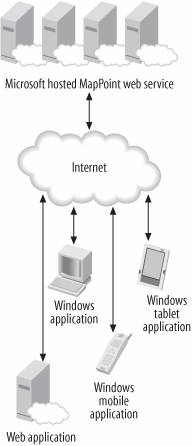Section 5.1. How Does MapPoint Web Service Work?
5.1. How Does MapPoint Web Service Work?Like any other web service, MapPoint Web Service enables you to develop distributed applications. By invoking MapPoint Web Service methods over the wire, you can perform many location-based tasks, such as finding places, finding addresses, calculating driving directions, rendering maps, and so on. All web service requests that invoke MapPoint Web Service methods must be authenticated using the credentials assigned to your MapPoint Web Service account (I will go into more detail on this subject later in the chapter). Once your request is successfully authenticated, MapPoint Web Service executes the corresponding method using your input parameters and returns an appropriate output wrapped in a valid response. While all this communication happens in SOAP, you do not need to get into the details of SOAP request or response to communicate with MapPoint Web Service; Microsoft .NET framework does a great job of abstracting away the wire-format level specifics. Figure 5-1 shows how your location-enabled applications communicate with MapPoint Web Service. Figure 5-1. How MapPoint Web Service works As you can see, any application you develop using MapPoint Web Service is a "connected" application, requiring your application to be able to communicate over the wire via the Internet. So, what are the advantages of a connected MapPoint Web Service-based application? There are many advantages to this model:
Now that you know how your applications communicate with MapPoint Web Service at a macro level, let's get started programming with MapPoint Web Service. |
EAN: 2147483647
Pages: 136